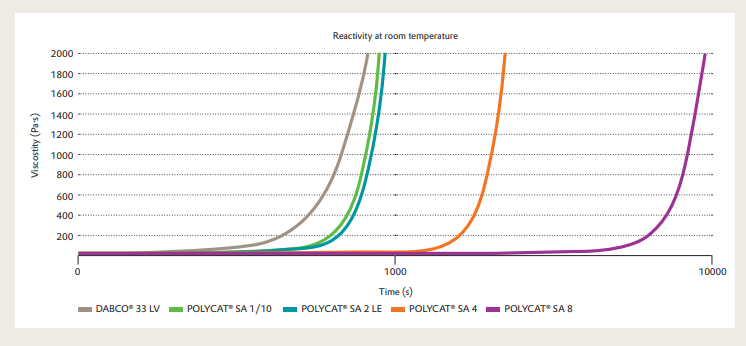Knowde Enhanced TDS
Identification & Functionality
- CASE Ingredients Functions
- Industrial Additives Functions
- Plastics & Elastomers Functions
Features & Benefits
- Materials Features
- Key Performance Benefits
- Non-hydrolyzable
- Delayed action catalysis
- Improved demold
Applications & Uses
- Applications
- Applicable Processes
- Compatible Polymers & Resins
- Industrial Additives End Use
- Plastics & Elastomers End Uses
- Product Applications
POLYCAT® SA 1 is recommended for evaluation as a co-catalyst with conventional catalysts in the following polyurethane systems:
- Integral skin: It accelerates cycle times with no effect on cream times.
- HCFC-141b-blown, water-blown and froth pour-in-place rigid systems.
Properties
- Physical Form
- Appearance
- Light brown liguid
- Miscible in
- Water
- Soluble in
- Water, Organic solvent
- Typical Properties
- Product Properties

POLYCAT® SA catalysts can be activated at different temperatures. By choosing the right catalyst you can tailor a delayed reaction and achieve both long pot-life and fast post-curing
| Value | Units | Test Method / Conditions | |
| Viscosity (at 25°C) | 433.0 | mPa.s | — |
| Density (at 25°C) | 1.07 | g/cm³ | — |
| Flash Point | 94.0 | °C | PMCC |
Technical Details & Test Data
- Viscosity Profiles in a Standard Aromatic Elastomer Formulation
Traditional polyurethane catalysts accelerate a polyol-isocyanate reaction at ambient conditions. However, when a delayed reaction profile is preferred, we offer the POLYCAT® SA series. These catalysts are activated by the natural exotherm generated during the formation of polyurethane or by using an external heat source, speeding up the cure time. POLYCAT® SA catalysts cure at different temperatures (as shown in the illustration below). By choosing the right catalyst you can tailor a delayed reaction profile to optimize your process and formulation.
The graphic below depicts the delayed action performance at ambient conditions of POLYCAT® SA 1/10, POLYCAT® SA 2 LE, POLYCAT® SA 4 and POLYCAT® SA 8. POLYCAT® SA 1/10 and POLYCAT® SA 2 LE have a more subtle delay. Due to its unique composition, POLYCAT® SA 2 LE can also be utilized to help reduce amine emissions. POLYCAT® SA 8 provides the longest delay as this catalyst activates at the highest de-blocking temperature. Additionally, the POLYCAT® SA series catalysts can be combined with other catalysts in our portfolio to optimize material properties and cure profile behavior.

Storage & Handling
- Shelf Life
- 12 months
- Storage Conditions
- Shelf life: minimum 12 months. For exact date of expiration, please consider CoA.
- Storage conditions: dry and cool place in factory-packed containers.
- Optimum storage temperature: 10 to 30 °C.

